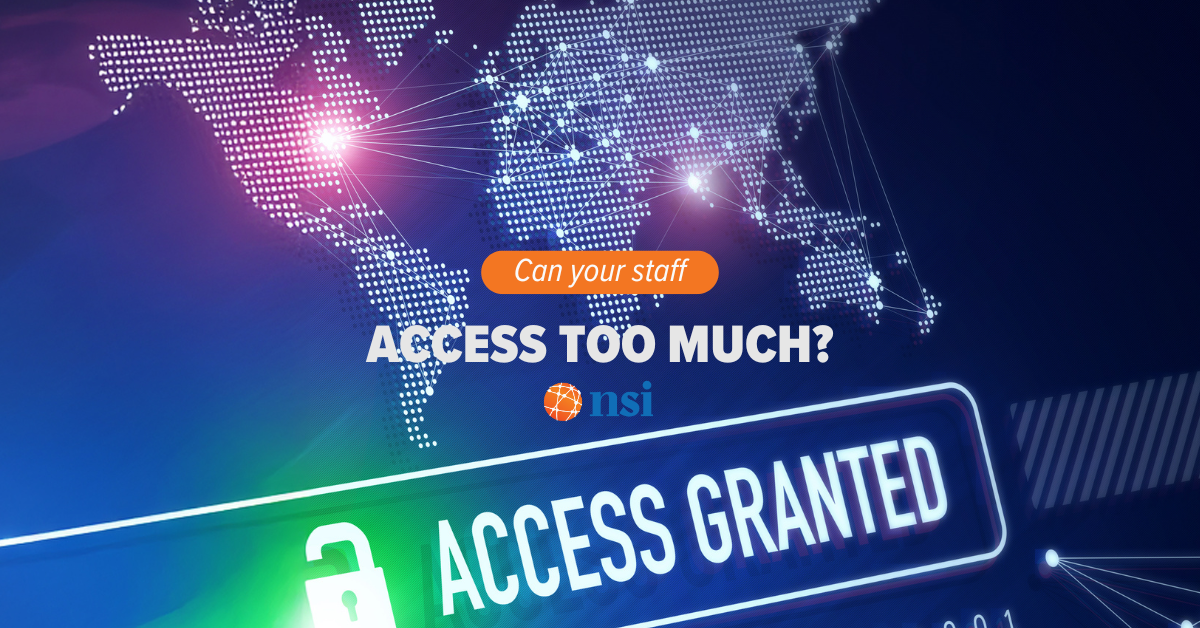Key Takeaways
- Nearly 50% of employees have access to more data than they need.
- Privilege creep—gradual access buildup over time—is a growing cybersecurity concern.
- Insider risk isn’t always malicious; it’s often caused by human error.
- Applying the least privilege principle and automating access controls prevents data exposure.
- Immediate removal of access for departing employees is essential.
- Regular reviews can reduce the risk of breaches, compliance issues, and data misuse.
Are You Sure Everyone in Your Business Has the Right Level of Access?
When was the last time you checked who can actually access your company’s data?
If your answer is “I think IT handles that,” you might want to think again.
Recent studies show that around half of employees have more access to data than necessary. That extra visibility might seem harmless—but it’s one of the leading causes of internal security incidents today.
At NSI, we’ve seen how excessive permissions can quietly open the door to big problems: data leaks, compliance violations, and operational headaches that could have been avoided with better access control.
The Hidden Risk Within: How Too Much Access Becomes a Threat
Every system your team uses—email, cloud apps, CRMs, shared drives—contains valuable information. Over time, as roles evolve and new tools are added, permissions get messy.
This creates what’s known as insider risk: threats that come from within your organization. These aren’t always intentional. In fact, most data exposure incidents stem from accidents, not attacks.
Common insider risks include:
- Employees sharing sensitive files by mistake.
- Outdated accounts remaining active after someone leaves.
- Contractors retaining access after a project ends.
And the biggest contributor? Privilege creep—when users slowly accumulate more permissions than needed because no one revokes their old ones.
Shockingly, nearly half of businesses admit ex-employees can still access systems months after leaving. That’s like giving someone the keys to your office—and never changing the locks.
How to Fix It: Adopt a “Least Privilege” Approach
The solution is straightforward but powerful: enforce least privilege access.
This means giving every employee the minimum level of access required for their role—nothing more. Combined with just-in-time access (temporary permissions granted only when necessary), this strategy drastically reduces exposure.
Here’s how you can start:
- Audit current permissions. Identify who has access to what and whether it’s justified.
- Automate access management. Use tools that review, assign, and revoke permissions regularly.
- Remove old accounts immediately. When someone leaves, their access should end the same day.
- Educate your team. Make data responsibility part of your culture.
Yes, managing permissions across dozens of systems—especially with today’s mix of cloud tools and AI apps—can feel overwhelming. But with NSI’s expertise, it’s entirely achievable.
We help businesses like yours create smarter, automated access policies that balance security with productivity.
Protect Data Without Slowing Down Your People
Some business leaders hesitate to tighten access, fearing it’ll make daily work harder. The truth? It actually makes operations smoother.
When access is cleanly structured and continuously monitored, employees spend less time digging through irrelevant systems and more time focused on their actual work.
At NSI, we believe modern cybersecurity isn’t about restriction—it’s about empowerment. The right access, at the right time, for the right people.
Conclusion
Your business data is your most valuable digital asset. Leaving it overexposed is like leaving your front door open.
By implementing least privilege access, conducting regular audits, and automating permission reviews, you can prevent insider risks before they happen.
At NSI, we make data security simple, scalable, and built for the way your business operates.
👉 Don’t wait until after a breach to take action. Contact NSI today to schedule your access control review and secure your data before it’s too late.
FAQs
1. What is insider risk?
Insider risk refers to potential data threats from within your organization—employees, contractors, or partners who have legitimate access but may misuse it accidentally or deliberately.
2. What causes privilege creep?
Privilege creep occurs when users collect access over time—usually due to role changes, temporary projects, or overlooked permissions.
3. What’s the least privilege principle?
It’s a cybersecurity best practice that limits users’ access to only what they need to do their job.
4. Why should access be removed immediately when staff leave?
Former employees retaining access can unintentionally or deliberately compromise data. Removing permissions immediately eliminates that risk.
5. How can NSI help manage access control?
NSI helps businesses assess, optimize, and automate data permissions to strengthen security and compliance—without disrupting productivity.
